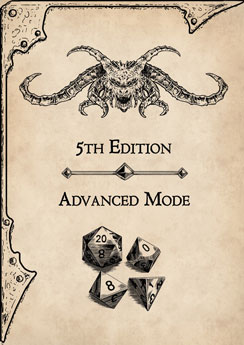Large beast (animal), unaligned
Armor Class 12 (natural armor)
Armor Class (suggested) 14 (natural armor)
Hit Points 26 (4d10+4)
Hit Points (suggested) 42 (5d10+15)
Speed 50 ft.
Proficiency Bonus +2
Proficiency Bonus +3 (5th Edition Advanced Mode)
| STR | DEX | CON | INT | WIS | CHA |
|---|---|---|---|---|---|
| 17 (+3) | 15 (+2) | 13 (+1) 16 (+3)* | 3 (-4) | 12 (+1) | 8 (-1) |
Skills Perception +3, Stealth +6
Senses passive Perception 13
Challenge 1 (200 XP)
Keen Smell. The lion has advantage on Wisdom (Perception) checks that rely on smell.
Pack Tactics. The lion has advantage on an attack roll against a creature if at least one of the lion’s allies is within 5 ft. of the creature and the ally isn’t incapacitated.
Pounce. If the lion moves at least 20 ft. straight toward a creature and then hits it with a claw attack on the same turn, that target must succeed on a DC 13 Strength saving throw or be knocked prone. If the target is prone, the lion can make one bite attack against it as a bonus action.
Rear Claws (suggested). If both claws hits, the lion may rake with both its rear claws dealing 6 (1d6+3) slashing damage each as a bonus action. No hit roll required.
Running Leap. With a 10-foot running start, the lion can long jump up to 25 ft..
ACTIONS
- Multiattack (suggested). The lion makes three attacks, one with its bite and two with its claws.
- Bite. Melee Weapon Attack: +5 to hit, reach 5 ft., one target. Hit: 7 (1d8 + 3) piercing damage.
- Bite (suggested). Melee Weapon Attack: +5 to hit, reach 5 ft., one target. Hit: 8 (1d10 + 3) piercing damage.
- Claw. Melee Weapon Attack: +5 to hit, reach 5 ft., one target. Hit: 6 (1d6 + 3) slashing damage.
- Claw (suggested). Melee Weapon Attack: +5 to hit, reach 5 ft., one target. Hit: 5 (1d4 + 3) slashing damage.
5th Edition Advanced Mode
Limiting the power of a character and making the overall difficulty of the game harder, does not reduce the creativity, indeed it does quite the opposite.
The Game Master has the option to use any and all of the instances proposed in this guide, or just some of them according to their preference.
It is the lack of something that move and motivate characters, not the abundance of it
DESCRIPTION
A lion is a large, feline beast with a tawny coat, a tufted tail, and a mane that surrounds its head. Lions are known for their strength, courage, and pride. They are often considered the kings of the beasts, and are revered by many cultures. Lions can grow up to 10 feet long and weigh up to 500 pounds. They have keen senses, especially their sense of smell, which helps them locate prey and avoid danger. Lions are social animals that live in groups called prides, which consist of one or more males and several females and their cubs.
COMBAT
Lions are formidable predators that hunt cooperatively with their pride members. They use their speed, stealth, and pack tactics to ambush and overpower their prey. Lions prefer to target large herbivores, such as buffalo, wildebeest, giraffe, and zebra, but they can also adapt to smaller prey, such as impala or warthog. Lions have powerful jaws and sharp teeth that can inflict piercing damage, as well as claws that can slash and rend flesh. Lions are also capable of pouncing on their prey, knocking them prone and biting them as a bonus action. Lions can also leap great distances with a running start, allowing them to cross obstacles or surprise their enemies.
HABITAT / SOCIETY
- Lions can live in a variety of habitats, ranging from open grasslands to woodlands to deserts. They are historically absent only from tropical rainforests and very arid deserts, although some desert-adapted lions manage to persist in areas of Namibia. Lions can even be found on beaches and mountain ridges, as long as there is sufficient prey and cover available. Lions need water relatively regularly, and often hang around the few remaining sources of water in their home range during the dry season. Areas around rivers also provide good stalking cover for lions, making them ideal hunting grounds.
Lions are highly social animals that form prides with a complex social structure. A pride typically consists of one or more males and several females and their cubs. The males are responsible for defending the pride’s territory from intruders and other threats, while the females are the main hunters and caretakers of the cubs. The males also mate with the females, ensuring the continuation of the pride’s lineage. The females cooperate with each other in hunting, raising the cubs, and grooming. The cubs play with each other and learn from their elders. The pride members communicate with each other through vocalizations, body language, and scent marking.
ECOLOGY
Lions play an important role in the ecology of their habitats. As apex predators, they help regulate the populations of their prey species, preventing overgrazing and maintaining a balance in the ecosystem. Lions also provide food for scavengers, such as hyenas, vultures, and jackals, who feed on the remains of their kills. Lions are also affected by the ecology of their habitats.
